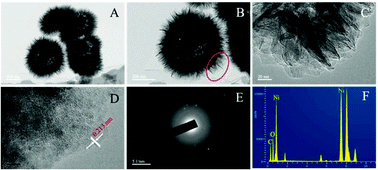One-pot green and simple synthesis of actinian nickel-doped carbon nanoflowers for ultrasensitive sensing of quercetin†
Abstract
In this contribution, a one-pot method possessing the advantages of easy preparation, rapidness, efficiency and environmental friendliness has been developed for the first time for the facile synthesis of highly fluorescent actinian nickel-doped carbon nanoflowers (Ni-CNFWs) by using nickel(II)acetylacetonate as a metal–carbon source. Various characterization studies indicate that metal nickel atoms have been successfully doped into carbon nanoflower frameworks with a weight percentage of 1.46 wt%. The Ni-CNFWs showed a “shell–core” actinian structure with ∼400 nm diameter and highly efficient fluorescence quenching ability in the presence of quercetin (Qut) due to the formed Meisenheimer complexes via the conjugation effect of p, π-electrons between Ni-CNFWs and Qut, which allowed the analysis of Qut in a very facile method. Under the optimal conditions, the decreased fluorescence of Ni-CNFWs showed a good linear relationship with the concentration of Qut ranging from 0.5 to 300.0 μM, and the limit of detection was 0.137 μM (3σ/k). Finally, the content of Qut in bovine serum was successfully detected with the novel on–off sensor, and the recoveries were 97.3–101.9%, which indicate that the constructed on–off sensor has a high selectivity and accuracy.



 Please wait while we load your content...
Please wait while we load your content...